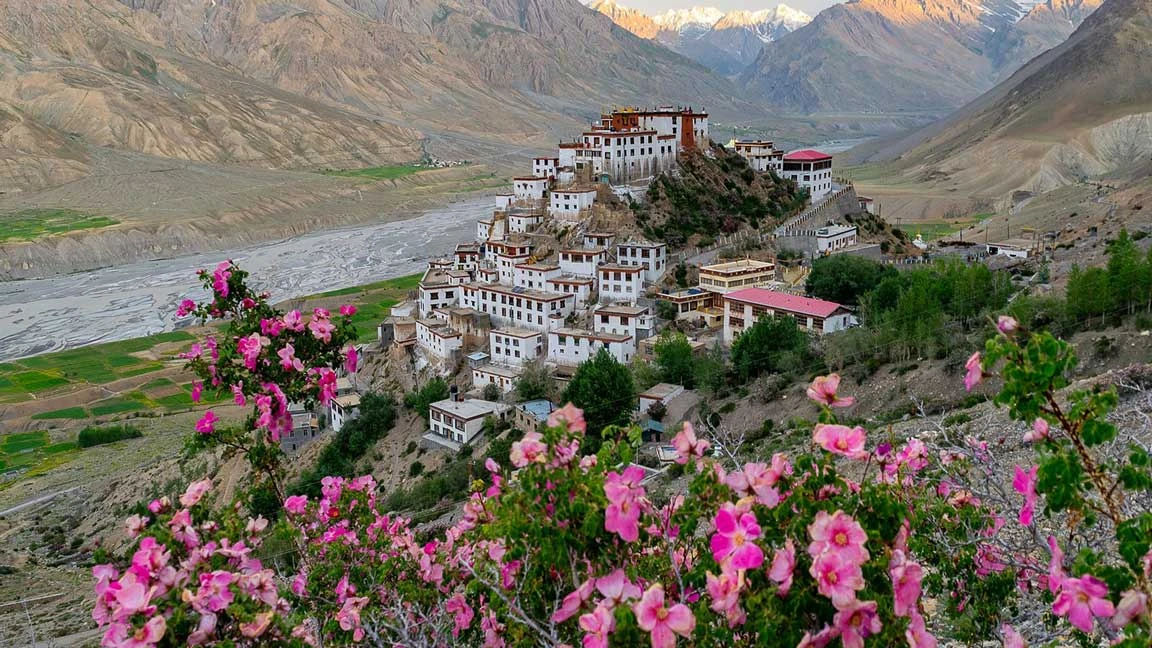
Key Monastery (also spelt Kee or Ki Monastery) is the largest and oldest Tibetan Buddhist monastery in Spiti Valley, located at an altitude of 4,166 meters (13,668 ft) near Kaza, Himachal Pradesh. Over 1,000 years old, this ancient monastery is believed to have been founded in the 11th century by Dromtön, a disciple of Atisha, a famous Tibetan teacher.
It’s home to over 250 monks, who live, study, and practice Buddhism here. The monastery follows the Gelugpa sect (Yellow Hat order) of Tibetan Buddhism, similar to the Dalai Lama.
The structure resembles a fortress with several floors, prayer halls, and murals that depict Buddha, deities, and thangkas. Its architecture resembles a stack of whitewashed, box-like rooms, making it one of the most photogenic landmarks of the Spiti Valley.
May to October is the best season, when roads to Spiti via Manali and Shimla are open.
In winter (November to March), the monastery looks magical under snow, but access is tough due to extreme cold and road closures.
If you want to witness festivals, the Cham Dance Festival (monks performing masked dances) is celebrated here in July.
Spiritual Ambience – Feel the calmness of Buddhist chants, meditation, and prayer wheels.
History & Heritage – A 1,000-year-old monastery with murals, rare manuscripts, and ancient weapons.
Scenic Views – Perched high above the Spiti River, it offers breathtaking panoramic views of the valley.
Cultural Experience – Interact with monks, learn about Tibetan Buddhism, and even attend a prayer session.
Photography Paradise – Its architecture, location, and backdrop of barren mountains make it iconic.
Attend Prayer Sessions – Witness monks chanting mantras with trumpets and drums.
Explore the Museum – Houses old thangkas, weapons, paintings, and scriptures.
Meditate – Spend quiet time in the monastery’s prayer hall.
Tea with Monks – Some travellers get the chance to have butter tea and chat with the lamas.
Photography – Capture its unique structure against the backdrop of the Spiti Valley.
Kibber Village (9 km) – Famous for snow leopard spotting in winter and one of the highest motorable villages.
Chicham Bridge (12 km) – Asia’s highest suspension bridge, connecting Kibber to Chicham village.
Langza Village (16 km) – Known as the fossil village with a giant Buddha statue overlooking the valley.
Hikkim Village (15 km) – Home to the world’s highest post office.
Komic Village (18 km) – The world’s highest motorable village with Tangyud Monastery.
Kaza Town (14 km) – Main town of Spiti with cafes, markets, and homestays.
Carry warm clothes even in summer, as temperatures drop in the evenings.
Spend at least an hour exploring and absorbing the monastery’s atmosphere fully.
Respect local customs—remove shoes before entering prayer halls.
Stay in Kibber, Kaza, or a local homestay for a deeper experience.
By Road:
From Manali (200 km, 8–10 hrs) – via Rohtang Pass, Kunzum Pass (open May–Oct).
From Shimla (430 km, 2–3 days) – via Kinnaur Valley (open most of the year).
The nearest town is Kaza (14 km), from where taxis, bikes, and local buses are available.
By Air:
Nearest airports: Bhuntar (Kullu, 250 km) and Shimla (450 km).
From there, continue by road.
By Rail:
Nearest railhead: Shimla (450 km) or Joginder Nagar (365 km), then by road.
The monastery offers simple meals (dal, rice, roti, butter tea) to visitors during festivals and special occasions.
Small tea stalls and cafes are available in Kibber, Kaza, and nearby villages.
Accommodation is limited, but some basic monastery guest rooms or dormitories may be available on request. Most travellers stay in homestays in Kaza, Kibber, or Langza for comfort.
Carry warm clothes – temperatures drop sharply, even in summer evenings.
Start early from Kaza to enjoy the monastery views with fewer tourists.
Don’t miss the sunset views of the valley from the monastery.
If visiting in winter, roads may be blocked – check conditions in advance.
Carry cash (ATMs are in Kaza only, and they often run out of money).
Dress – cover shoulders and knees when entering monasteries.
Remove shoes before entering prayer halls.
Seek permission before photographing monks or rituals.
Respect silence during prayer sessions.
Avoid plastic waste – carry reusable bottles and bags.
Support locals – stay in homestays, eat at local cafes, buy local handicrafts.
Be mindful of altitude – acclimatize in Kaza before heading higher.